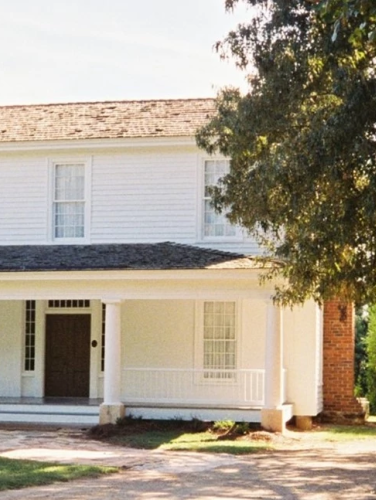
James A. Blakeney House
(ca. 1845)
Originally located in Pineville, Hennigan Place was the plantation home of an anti-secessionist who profited significantly from the use of enslaved labor.
3603 Tilley Morris Rd, Matthews, NC 28105
Hennigan Place, the Greek Revival styled home of James Edward Hennigan (1811-1876), was originally located in a rural setting on a hill adjacent to the James K. Polk birthplace site southeast of Pineville, North Carolina. In 1834, Hennigan married Sarah A. Stewart, whose father had purchased the Polk birthplace when the Polk family moved to Tennessee. The Hennigans had at least three children – two daughters and a son – before Sarah passed away in the mid-1840s. In 1848, James married Margaret H. Orr (1816-1860). Their union produced at least four children, three sons and a daughter. The daughter, Margaret Eugenia Hennigan, died in infancy and is buried beside her parents in the cemetery at Charlotte’s Sharon Presbyterian Church. Her mother Margaret H. Hennigan died in 1860 at the age of forty-two. Following the outbreak of the Civil War, Hennigan’s oldest son James Edward Hennigan Jr. (1844-1919) enlisted as a private in Company F of the North Carolina 49th Regiment.
Property Quick Links
The elder James Hennigan was a prominent farmer in southern Mecklenburg County. He also participated actively in public affairs, including service as an official of the Court of Pleas and Quarter Sessions of Mecklenburg County, the major organ of county government before 1868. During his early life, according to the Daily Charlotte Observer, “he was entrusted with important offices, which he filled with dignity and to the satisfaction of his constituents.” There is reason to believe that Hennigan was a leading local opponent of the South’s secession from the Union. However, as one of Mecklenburg County’s largest owners of enslaved persons, Hennigan depended heavily on enslaved labor for the success of his agricultural operations. He enslaved some twenty-three people as of the 1850 U.S. Census, a number that increased to thirty persons as of 1860. On the eve of the Civil War, he was among the wealthiest planters in southern Mecklenburg County. Hennigan died of heart disease in 1876.
The descendants of James Hennigan occupied the home until 1914, when James L. Hennigan sold the property to Stephen L. Manson. The Mansons lost the property during the Great Depression. By the early 1970s, Hennigan Place was vacant and in a dilapidated condition. The house was purchased by Charlotte natives Peter D. and Betty Shulenberger Snow, who began the process of restoration. In 1971, they moved Hennigan Place from its original site to a location immediately across U.S. 521. Two years later, they moved the house again, this time about ten miles to its present site on Tilley Morris Road. In this second move, the Snows specifically chose a location that duplicated as closely as possible the rural nature of the structure’s original setting.

